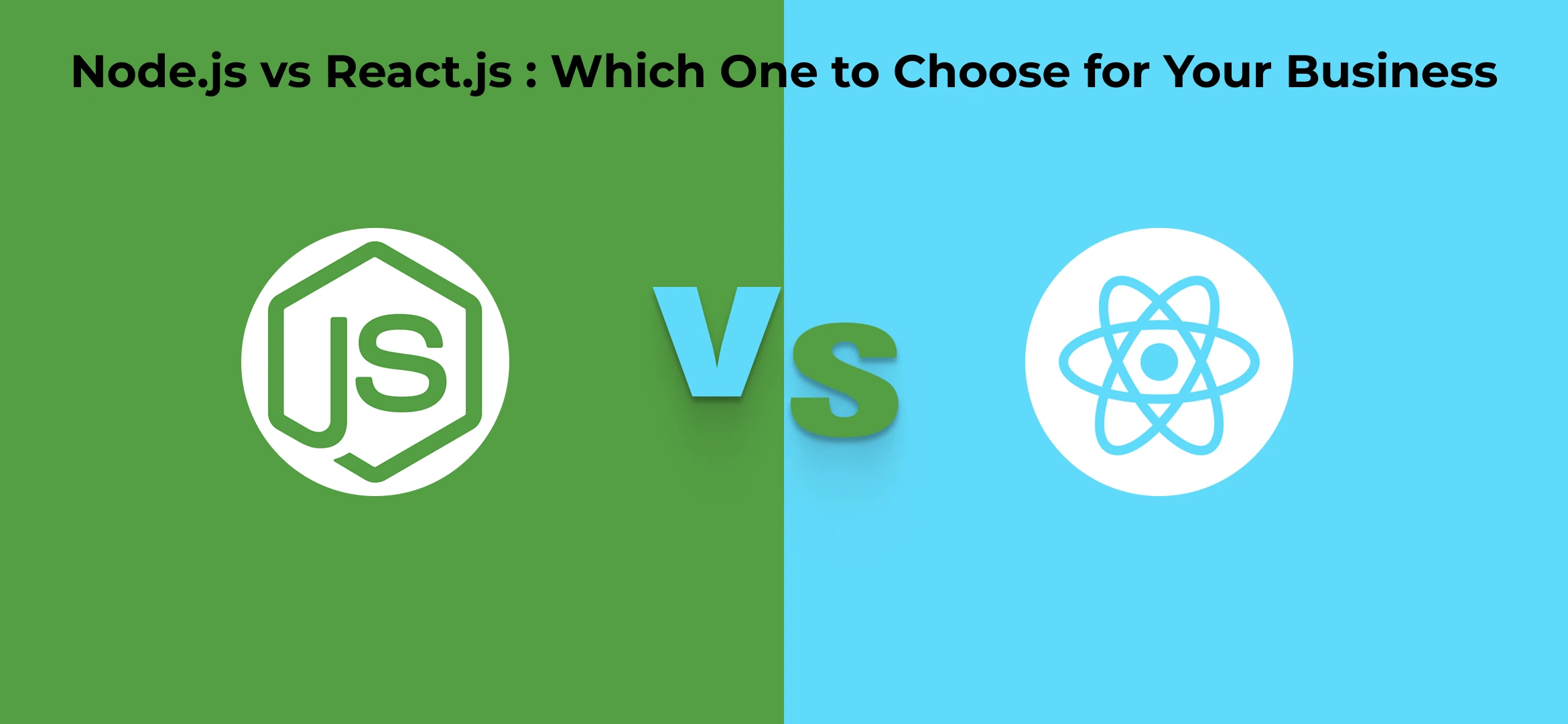The digital world is always changing, and so are the tools we use to shape it. It’s pretty common to hear ‘Node.js’ and ‘React.js’ tossed around together, which can lead to a bit of confusion. Are they frameworks? Libraries? Languages? The truth is, even though both are powerful technologies based on JavaScript, they have very different roles. Knowing the difference between Node.js and React.js is key for any business looking to create strong web applications.
To put it simply, Node.js is a runtime environment that lets you run JavaScript on the server side, making it possible to build scalable backend applications. In contrast, React.js is a JavaScript library aimed at creating dynamic and interactive user interfaces on the client side.
This blog is here to clear up the Node.js vs. React.js discussion, giving you a straightforward look at their strengths and when to use each one. We’ll dive into what they do best, highlight their unique benefits, and help you decide whether Node.js, React.js, or maybe even both are the right fit for your business needs. While they often work hand in hand in full-stack development, it’s important to understand that they can also shine on their own, each excelling in its own area. Let’s explore this tech landscape together and find out which tool—or perhaps both—will be the best match for your project.
Defining Node.js
When it comes to creating robust and scalable web applications, Node.js really shines as a powerful and flexible tool. But what is Node.js, exactly? At its heart, Node.js is a server-side JavaScript runtime environment. This means it lets you run JavaScript code outside a web browser, right on a server. Unlike traditional server-side languages, Node.js uses a non-blocking, event-driven architecture.
This design is essential for efficiently managing multiple concurrent connections, making it perfect for applications that demand high performance and quick responsiveness. A key player behind Node.js is the V8 JavaScript engine, which is the same engine that powers Google Chrome. This engine compiles JavaScript code into machine code, allowing Node.js to execute JavaScript at incredible speeds.
Key Features and Benefits that Make Node.js So Popular
- Scalability and Performance: Thanks to its non-blocking, event-driven architecture, Node.js can manage a huge number of simultaneous connections effortlessly. This makes it an ideal choice for applications that need to grow quickly.
- Full-Stack JavaScript Development: With Node.js, developers can use JavaScript for both the front-end and back-end of their applications. This not only streamlines the development process but also makes it more efficient.
- Large and Active Community: Node.js is supported by a lively and extensive community, which means there are plenty of resources, libraries, and support available. This community is a driving force behind innovation and keeps the technology fresh and relevant.
- NPM (Node Package Manager): NPM is the largest software registry in the world, offering a vast array of open-source JavaScript packages. This makes it super easy to integrate third-party libraries and modules into your Node.js applications.
- I/O Operations: Node.js shines when it comes to handling I/O-intensive tasks, like reading and writing files or managing network operations. Its asynchronous design ensures that these tasks don’t block the main thread, leading to better overall performance.
Defining React.js
In the realm of front-end development, React.js has truly emerged as a powerhouse, giving developers the tools they need to craft engaging and interactive user interfaces. But what is React.js all about, and what makes it such a favorite among developers?
At its core, React.js is a JavaScript library designed for building user interfaces. Unlike a comprehensive framework, React hones in on the view layer of your application. It utilizes a component-based architecture, breaking down UI elements into reusable and independent components. This approach leads to modular and maintainable code, simplifying the process of creating complex UIs.
One of the standout features of React is the Virtual DOM. Rather than directly altering the actual Document Object Model (DOM), React generates a virtual version of it. When changes happen, React smartly updates only the parts of the real DOM that need it, leading to impressive performance gains. It’s worth mentioning that React.js is primarily a front-end library, which means it runs within the user’s browser.
Key Features and Benefits that Make React Stand Out
- Reusable Components: With React’s component-based approach, you can create UI elements that are reusable, which not only saves you time during development but also keeps your application looking consistent.
- Improved Performance: Thanks to the Virtual DOM and smart rendering algorithms, React delivers outstanding performance, particularly for apps that require frequent updates to the user interface.
- Strong Community Support: One of React’s biggest strengths is its vibrant and active community. You’ll find a wealth of resources, tutorials, and support available, all of which help drive the ongoing development and enhancement of the library.
- Rich Ecosystem of Libraries: React is surrounded by a rich ecosystem of third-party libraries and tools that expand its capabilities and make common development tasks a breeze.
- Declarative Syntax: React’s declarative syntax lets you specify how your UI should appear based on the current state of the application. This approach not only makes your code more readable but also easier to grasp.
Node.js vs. React.js: Learning Key Differences
| Feature | Node.js | React.js |
|---|---|---|
| Purpose | Server-side JavaScript runtime environment | JavaScript library for building user interfaces |
| Primary Use | Backend development, server-side logic, APIs | Frontend development, user interface components |
| Execution Environment | Server-side (runs on a server) | Client-side (runs in the browser) |
| Architecture | Event-driven, non-blocking I/O | Component-based, Virtual DOM |
| Language | JavaScript (runtime environment) | JavaScript (library) |
| Key Features | Scalability, I/O handling, NPM | Reusable components, Virtual DOM, declarative syntax |
| Use Cases | Real-time applications, APIs, microservices, backend for SPAs | Single-page applications (SPAs), complex UIs, mobile apps (React Native) |
| Community | Large and active, focused on server-side development | Large and active, focused on UI development |
| NPM Usage | Used for package management of server-side tools and libraries | Used for package management of front-end tools and libraries |
NodeJS + React: A Powerful Combination In 2025

The partnership between Node.js and React.js is truly transforming the landscape of web development, reinforcing their reputation as a formidable duo as we approach 2025. This powerful combination empowers developers to create full-stack applications with remarkable efficiency and performance. Knowing when to choose Node.js over React.js is essential for unlocking their full potential. Node.js, with its non-blocking I/O model and ability to run JavaScript on the server side, is fantastic for managing backend tasks. When it comes to backend development, Node.js offers a solid framework for building APIs, managing databases, and executing server-side logic.
On the flip side, React.js, a front-end JavaScript library, excels at designing interactive and engaging user interfaces. If you’re weighing Node.js vs React.js for frontend development, React.js stands out with its component-based structure and virtual DOM, which together create a smooth and efficient user experience.
By utilizing Node.js for the server side and React.js for the client side, developers can craft scalable, maintainable, and high-performance web applications that cater to the needs of today’s users. This synergy promotes a unified JavaScript development approach, simplifying the workflow and enhancing overall efficiency.
Conclusion
In a nutshell, Node.js and React.js are both built on JavaScript, but they each have their own unique roles in web development. Node.js is all about creating a strong server-side environment, making it perfect for developing scalable backend applications and APIs. On the other hand, React.js is designed to help developers craft dynamic and interactive user interfaces on the client side. The main differences between them come down to where they run, how they’re structured, and what they’re primarily used for.
If you’re still figuring out the best technology for your project, or if you’re eager to harness the combined strengths of Node.js and React.js for a state-of-the-art web application, Echoinnovate IT is here to assist you. Our skilled team of developers has the know-how to guide you through the entire process, offering customized solutions that fit your business objectives. Reach out to Echoinnovate IT today to chat about your project and tap into the full potential of these amazing technologies.
How Much Does It Cost to Build a Real Estate App Like Bayut in Dubai?
What is the main difference between Node.js and React.js?
Node.js is a server-side JavaScript runtime for building backend applications, while React.js is a frontend library for creating user interfaces.
Can Node.js and React.js be used together?
Yes! You can use Node.js for backend development and React.js for frontend UI, making them a great combination for full-stack applications.
Which is better for web development: Node.js or React.js?
It depends on your needs:
Choose Node.js for backend APIs, real-time apps, and microservices.
Choose React.js for interactive UIs, single-page applications (SPAs), and front-end development.



